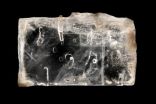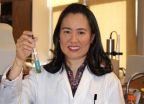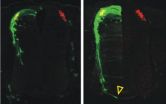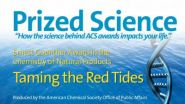(Press-News.org) BINGHAMTON, NY – Binghamton University researchers recently revived ancient bacteria trapped for thousands of years in water droplets embedded in salt crystals.
For decades, geologists have looked at these water droplets — called fluid inclusions — and wondered whether microbes could be extracted from them. Fluid inclusions have been found inside salt crystals ranging in age from thousands to hundreds of millions years old.
But there has always been a question about whether the organisms cultured from salt crystals are genuinely ancient material or whether they are modern-day contaminants, said Tim Lowenstein, professor of geological sciences and environmental studies at Binghamton.
Lowenstein and Binghamton colleague J. Koji Lum, professor of anthropology and of biological sciences, believe they have resolved this doubt. And they've received $400,000 from the National Science Foundation to support further research on the topic.
Lowenstein's team, which has been pursuing this problem for years, began by examining the fluid inclusions under a microscope. "Not only did we find bacteria, we found several types of algae as well," he said. "The algae actually may be the food on which the bacteria survive for tens of thousands of years."
When Lum got involved, the researchers began to wonder about the DNA of the organisms they were finding.
"You have a little trapped ecosystem," Lum said. "Some of these guys are feeding on other ones trapped in this space. The things that aren't alive in there, their DNA is still preserved."
Lum's graduate student Krithivas Sankaranarayanan reviewed existing literature on ancient DNA and helped to develop a protocol for use with Lowenstein's samples.
"We have these samples going back from the present to over 100,000 years in one exact location," Lum said. "So Tim can look at the salinity and reconstruct ancient climates. Now we're looking at the DNA from bacteria, the algae, the fungi and what was living in those waters and how those things changed over time. We have a view of all the different organisms that were in the lakes at the time these inclusions were formed."
The researchers sequence the DNA and culture the bacteria they find. Then it's time to think big. Lum's most optimistic view of the project goes like this: "It's possible that we can observe organisms evolving and see how they're reacting to climate change over geologic time."
The samples Lowenstein works with are drawn from Death Valley and Saline Valley in California as well as from sites in Michigan, Kansas and Italy.
Temperatures at these locations may have reached 130 degrees Fahrenheit in the past, and the pockets of water trapped inside the rocks are generally very salty.
The environment may sound harsh — in fact, it's among the most extreme on Earth — but the creatures that survive there are tough.
"These are some of the hardiest beasts on the planet," Lum said. And the conditions inside these water droplets are ideally suited to preserving DNA.
"They're like time capsules," Lowenstein agreed.
INFORMATION:
For more Binghamton University research news, see http://discovere.binghamton.edu/
Researchers kick-start ancient DNA
2010-11-23
ELSE PRESS RELEASES FROM THIS DATE:
MU scientist develops salmonella test that makes food safer, reduce recalls
2010-11-23
VIDEO:
University of Missouri researchers have created a new test for salmonella in poultry and eggs that will produce faster and more accurate results than most currently available tests.
Click here for more information.
COLUMBIA, Mo. –Earlier this year, an outbreak of salmonella caused by infected eggs resulted in thousands of illnesses before a costly recall could be implemented. Now, University of Missouri researchers have created a new test for salmonella in poultry ...
Cutting-edge salivary diagnostics research presented at AADR 3rd Fall Focused Symposium
2010-11-23
Alexandria, Va. – The American Association for Dental Research (AADR) held its 3rd Fall Focused Symposium on November 12-13, in the Washington, DC, area. This year, the theme was the fast-moving field of Salivary Diagnostics, with a focus on Scientific & Clinical Frontiers. The symposium was sold-out, but AADR also offered a live Webinar broadcast of the oral sessions.
AADR created the Fall Focused Symposium under the objective to provide networking opportunities and exchange of ideas, and to offer small regional symposia focused on cutting-edge technology and techniques. ...
Speed heals
2010-11-23
Both the rate and direction of axon growth in the spinal cord can be controlled, according to new research by USC College's Samantha Butler and her collaborators.
The study, "The Bone Morphogenetic Protein Roof Plate Chemorepellent Regulates the Rate of Commissural Axonal Growth," by Butler; lead researcher Keith Phan and graduate students Virginia Hazen and Michele Frendo of USC College; and Zhengping Jia of the University of Toronto, was published online in the November 17 issue of the Journal of Neuroscience.
Butler, assistant professor of biological sciences, found ...
New tool detects Ebola, Marburg quickly, easily
2010-11-23
BOSTON (11-22-10) -- Boston University researchers have developed a simple diagnostic tool that can quickly identify dangerous viruses like Ebola and Marburg. The biosensor, which is the size of a quarter and can detect viruses in a blood sample, could be used in developing nations, airports and other places where natural or man-made outbreaks could erupt.
"By enabling ultra-portable and fast detection, our technology can directly impact the course of our reaction against bio-terrorism threats and dramatically improve our capability to confine viral outbreaks," said Assistant ...
Ultrathin alternative to silicon for future electronics
2010-11-23
There's good news in the search for the next generation of semiconductors. Researchers with the U.S. Department of Energy's Lawrence Berkeley National Laboratory (Berkeley Lab) and the University of California (UC) Berkeley, have successfully integrated ultra-thin layers of the semiconductor indium arsenide onto a silicon substrate to create a nanoscale transistor with excellent electronic properties. A member of the III–V family of semiconductors, indium arsenide offers several advantages as an alternative to silicon including superior electron mobility and velocity, ...
Hybrid tugboat cuts emissions, University of California, Riverside study shows
2010-11-23
RIVERSIDE, Calif. (www.ucr.edu) --A new study by University of California, Riverside scientists of what is believed to be the world's only hybrid electric tugboat found that the vessel is effective in reducing emissions at the Ports of Los Angeles and Long Beach.
Researchers at the UC Riverside College of Engineering Center for Environmental Research and Technology (CE-CERT) demonstrated the hybrid electric tugboat reduces emissions of soot by about 73 percent, oxides of nitrogen (which help cause smog) by 51 percent, and carbon dioxide, which contributes to global warming, ...
Overweight primarily a problem among wealthier women in low- to middle-income countries
2010-11-23
Boston, MA – A new study from the Harvard School of Public Health (HSPH) finds that high body mass index (BMI) in developing countries remains primarily a problem of the rich. The findings suggest that the shift towards overweight and obesity among the poor that has already happened in wealthier countries has not yet happened in developing countries.
The study appears in an advance online edition of the American Journal of Clinical Nutrition and will appear in an upcoming print edition.
"Previous research on the increasing overweight and obesity burden in developing countries ...
Mayo Clinic study finds aggressive surgery is best for children with brain tumors
2010-11-23
ROCHESTER, Minn. -- A new Mayo Clinic study (http://newsblog.mayoclinic.org/2008/12/03/brain-tumors-best-treatments-for-long-term-survival/) found that children with low-grade brain tumors (gliomas) (http://www.mayoclinic.org/brain-tumors/) who undergo aggressive surgery to completely remove the tumor have an increased chance of overall survival. If complete removal is not possible, adding radiation therapy to a less complete surgery provides patients with the same outcomes as a complete removal. This study was presented at the Society for NeuroOncology Annual Scientific ...
New American Chemical Society Prized Science video focuses on shrinking the computer chip
2010-11-23
WASHINGTON, Nov. 22, 2010 — The science that helped make today's smartphones and iPods smaller but more powerful than yesterday's desktop computers highlights the latest episode in the American Chemical Society (ACS) Prized Science video series.
The new high-definition video, released today, focuses on IBM chemist Robert Miller, winner of the 2010 ACS Award for Chemistry of Materials. Miller developed materials that helped pack more transistors onto each computer chip, those postage stamp-size slivers of silicon that make up the brains of computers and other electronic ...
University of Minnesota engineering researcher finds new way to fight antibiotic-resistant bacteria
2010-11-23
New findings by civil engineering researchers in the University of Minnesota's College of Science and Engineering shows that treating municipal wastewater solids at higher temperatures may be an effective tool in the fight against antibiotic-resistant bacteria.
Heating the solid waste to 130 degrees Fahrenheit (55 degrees Celsius) was particularly effective in eliminating the genes that confer antibiotic resistance. These genes are used by bacteria to become resistant to multiple antibiotics, which are then known as "superbacteria" or "superbugs."
The research paper ...



